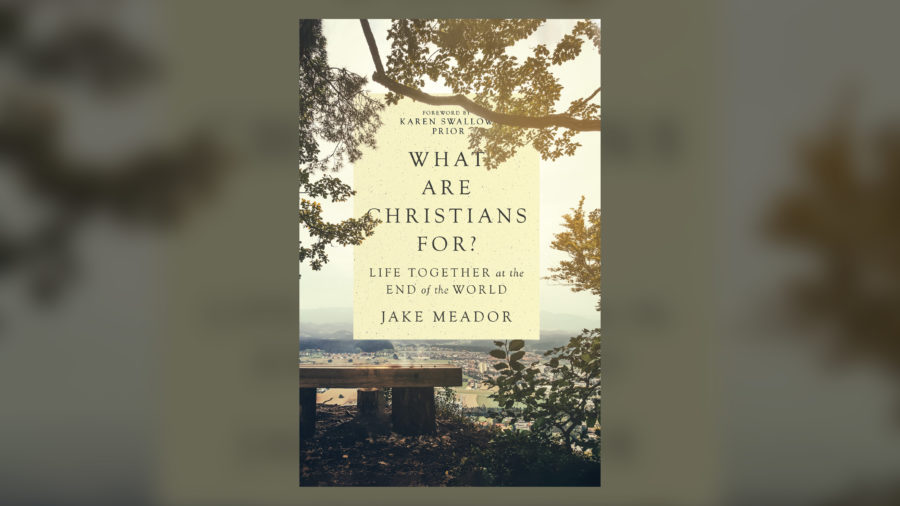
Near the beginning of Jake Meador’s new book, he speaks of the “possibility of persuasion” when people share “reality together through observation and careful thought, and then reason about it together” (27). I thought about persuasion often while reading this book, mainly because I found little attempt on the part of the author to persuade, or at least to persuade people like me. The title What are Christians for? suggested to me, a Christian, that I would learn what I’m for, and I suppose I did—being a white male Christian. As a white man, I play the villain in an American creation-fall-redemption narrative. To be sure, I’m not offended that I’m at the center of a narrative; I’m disappointed that the author felt no need to reason with me about it.
Indeed, the “reasons” given show an interesting rhetorical two-step: assert something bad about the Western world and blame it on the white male; or assert something good and then blame its opposite on the white male. This is the pattern throughout the book, and in this way the work reflects the new conditions of persuasion in the Christian world—not the rational demonstration of conclusions but the author’s credibility to make assertions. Meador—a white male—can “prove” his assertions only by out-grouping himself and by speaking ill of his civilization.
Creation
The chapters flow according to a creation/fall/redemption schema in which Meador gives a grand narrative of Western social and economic development. The first chapter characterizes God’s creation as a gift with meaning; it is good and for our good. It is not bare material for our extraction and use. I agree that creation is gift of God that we are stewards of it and that nature reveals the Creator and is an object of wonder and contemplation. His law is for our good. But this chapter reveals from the outset a dubious view of nature that operates throughout the book. He tells us that this “world is not something we should seek to escape through conquest or bend to our will through technique, power, or control” (31). A lot is going on in that sentence, but Meador fails to acknowledge that nature is or was a place of danger, fear, and resistance—it required masculine strength, will, and resolve to subdue and to establish and maintain conditions for men and women to live well. But Meador’s conception of nature is an already-conquered nature, a domesticized nature; or, rather, he assumes that if only we had an outlook like Disney’s Pocahontas, we’d be one with nature and animals would gleefully dance around us. Who needs to subdue the earth by strength of will when the feminine mystique and “mother earth” are all we need? Let me suggest the contrary: that Meador’s own conception of nature is a product of rough men domesticizing it, making it safe for him to contemplate and enjoy it (and to be their accuser). Nature apart from the imposition of human will is terrifying. The fact that it doesn’t terrify indicates that human will has tamed it. Meador’s disneyfied presentation of nature sets the stage for the white man’s original sin and for a series of revolutions culminating in our “increasingly cold, cruel, and heartless” society (20).
Fall
Central to Meador’s narrative of American history is what he calls the “great uprooting”. As he tells it, the pre-colonial peoples of North America had a deep connection of “people and place.” He emphasizes the concept of place, rightly distinguished from cite, as something “heavy with life, even overflowing. The good life for human beings is the life that exists in concert with the life of the world” (35). The reader is left with the impression the Amerindians were entirely noble, never warring nor committing genocide nor seizing land nor enthralled with idolatry nor sacrificing and torturing fellow man. It’s as if North America was Lewis’ Malacandra. But Meador’s main concern is that the European settlers, after stealing the land, “did not seek to inform their identity in this new place in the same way” (38). They “reduced” the land to “mere matter”. The Europeans did not become Amerindians and, even worse, they never established a connection of people and place. He writes, “when the Europeans arrived in the New World, they chose to identify themselves in ways that broke the essential bond between the body and the earth” (39). He then states that the “culture was denied a voice in shaping identity. Language was denied a voice. Landscapes and geography were denied a voice” (41).
What’s astonishing is not only that Meador makes these claims with almost no evidence, he universalizes them under the term “whiteness,” which he repeats throughout the book. He offers no acknowledgement of distinct regional cultures in North American among people of European ancestry—the Puritans in New England, the Quakers in mid-Atlantic region, English Cavaliers in the coastal South, the Anglo-Scottish in the Appalachian hinterland, and many others. All these peoples generated a real connection of people and place that survives this day, and later arriving Europeans shaped the landscape as well. Meador uncritically sites Vine Deloria, a Sioux theologian, who claims that the white man “does not listen to the land and so cannot find a place for himself” (41). This is preposterous. There is restlessness in the American way of life; that can’t be denied. But the idea that white Americans lack a sense of place is pure fantasy. If anything, it is projection of one’s own sense of placelessness, existential angst, or extreme antipathy for one’s fellow Americans. The problem that such resentful people have with white Americans is not that they lack a sense of place, but that they stubbornly cling to it.
The great sin of whiteness, says Meador, is “imposing your will onto the world around you through force, to seize what you desired, and to claim the life you wanted” (42). I’m bewildered by this call of the wild for a few reasons. The first is that Meador and those who agree with him are free to live in teepees or mud huts, if they so desire. Second, “imposing your will” is precisely what you do in subduing the earth, which is a divine command. Thirdly, and most importantly, Meador’s proper target ought to be wealthy people, who own the means of production and who seek out ways to exploit resources. But he doesn’t make that classical leftist distinction between capitalist and working-class, choosing rather the New Left’s implication that all white people are guilty of exploitation. You can’t leave the ordinary American an escape route from their complicity. He goes on to say that the “regime of force,” which white people learned in the New World, led to “the violent destruction of the created world” (47). This is quite the exaggeration, and in terms of “destruction,” the Western world is far from the biggest culprit today (see East Asia and Africa). Despite all the condemnation along racial lines (which should be treated with care), Meador fails to seriously support any of his conclusions.
Next, we have the “great unsettling,” or the industrial revolution. Here Meador explains the “logic” behind industrialism—the “colonial mind” moves from “violence done to the people who loved the land” to being “enacted on the land and animals” (50). He later says, “the spirit that defined their [the colonists] to that encounter [with the Americas] is also the spirit that defines industrialism” (61). It’s a wonderfully simple narrative—placeless colonists exploit non-white bodies and learn to exploit the land. The problem is that the industrial revolution began in England, not North America; and, anyway, Meador offers scant evidence for this “logic”. Anyone predisposed to hate on white people will find this narrative convincing, of course. They are prepared to believe it. But the convincing isn’t rational. He concludes by saying that industrialization “was a further step toward universalizing whiteness” (62). Does this mean that industrialized countries, such as China, South Korea, India, and others, which are neither white nor western, have succumbed to “whiteness”? Should we then thank whiteness for lifting hundreds of millions out of poverty?
The “logic” that flows from the “story of colonialism” to the “story of industrialism” leads to contraception and abortion. This last revolution, the sexual revolution, arose from “ideas about the human person that had been in the air for several centuries and applying them to sexuality” (69-70). It reflects the “willingness to suppress or even eliminate some forms of life for the benefit of other forms of life” (69). Meador repeats the same narrative a few pages later, this time emphasizing “whiteness” and even mentioning the Spanish conquistadores (75). Support for this sweeping narrative of revolutions is terribly thin, and he resorts to simply restating his “logic” over and over and quoting people who simply affirm his assertions. Again, Meador will convince many because he is identifying bad things in the Western world and he blames white men for it, and perversely many white people find it euphoric to read about how bad they are. Who needs evidence when the self-deprecating logic, the self out-grouping, and the stoking of deep resentment are so persuasive?
Thus ends the “fall” part of the narrative. The dark irony here is that Meador’s narrative is the very thing that displaces “white” people. When your land is declared “stolen land;” when your way of life is racist and misogynist; when your entire history, along with your ancestry, is one of exploitation, force and destruction; when your heritage is “uniquely compromised” (10)—what is your relationship to place except negativity, guilt, and self-hatred?
Redemption
Given this psychological dissonance, it should come at no surprise that Meador’s ideas for white redemption are profoundly white. He first tells a story about pulling weeds with friends in a forest outside two L’Abri houses in Minnesota. After an afternoon of it, during which it rained, he and his friends warmed up next to a fire in a house listening to a Nora Jones album. This memory is very important to him, and that is fine. But to me it is rather uninteresting. Still, Meador uses it to instruct us in how to be good neighbors and how to belong to a community. Consider me confused. A white woman planting flowers in front of her single-family suburban house does more for her neighbor than what Meador did. Is there anything more white than thinking that pulling weeds in a forest is worthy of praise? I once saw a group of people in Baton Rouge, Louisiana cleaning the tombstones and cutting overgrown grass in an old black cemetery—every worker was white. It’s goofy, but it’s what we do, and I doubt that anyone thanked them for it.
But Meador insists that “whiteness” has made us “hostile to belonging, making the possibility of ‘home’ less and less real” (94). He goes on to say that “the world has felt more and more foreign to us” (95). The remedy is what he calls “receptive openness.” This is the “alternative to the ideology of whiteness.” I marvel at the delusion. Is there anything more white than receptive openness? The United States has willingly (at least with regard to policy or its lack of enforcement) received so many immigrants in the last 60 years that there will soon be fewer whites than non-whites. Western Europe has taken in tens of millions of non-Europeans. Now, I’m not congratulating the West—it was a mistake and, in my view, immigration (both legal and illegal) to the United States should be near zero. But to say that “whiteness” precludes receptive openness is just baffling. The best explanation is that Meador’s argument, far from restoring emplacement, works only to displace the heart in order to further demographic displacement. And in doing so, he actually exploits true whiteness—for whiteness is receptive openness, it is a self-destructive contradiction, it is a will to die. Thus, we see manifested in the Western world certain contradictions: to have a place you must be displaced; to belong somewhere you must belong nowhere; to have a people you must identify with all people; and to be good you must be immutably bad and act only for the good of the outsider.
Most white people in the United States and Europe indeed feel less and less at home and more and more foreignness. But it isn’t because of some ideology that began five hundred years ago. Rather, it is the limitless flood of immigration, the unchecked crime, and the hostile capture and racialization of institutions. There was plenty of belonging and sense of home, until recently. If “whiteness” is anything, it is a set of contradictions that leads to one’s own displacement.
In a few places, Meador praises the Bruderhof, an anabaptist community in upstate New York. He envisions an “almost Bruderhof” for all of us non-anabaptists. This betrays the contradictory nature of Meador’s project. The Bruderhof in upstate New York is largely composed of white people, who follow a highly particular set of practices with strict conditions of membership. To my knowledge, there are no Muslims, Hindus, Buddhists, homosexuals, queers, atheists, Lutherans, Presbyterians, Roman Catholics, or Mormons living as part of the Bruderhof community, nor is there any pressure to open up the Bruderhof borders to diversify. (Are they too on stolen land?). Now, I have no problem with this homogeneity in itself, but Meador’s “almost” is doing a lot of work, especially if he wants us to be radically receptive. I’d actually prefer that we were more like the Bruderhof community in this regard—radically exclusive. But that is not allowed for the non-anabaptists. Can a radically exclusive community really be a model for radical inclusivity?
Meador heavily relies on the life and work of Martin Bucer, the 16th century Reformer of Strasbourg, as a model of Christian character and social policy. My dispute with Meador on Bucer is based on the fact that Bucer assumed for this social doctrine a Christian community in which the same people are under both the civil and ecclesiastical administrations. Thus, the poor that received charity were under the watch and care of both the church and the civil administration; that is, they were under overlapping authorities that could regulate the proper use of charity they received. Meador fails, to my mind, to make this distinction and thus sends us off to care for the poor under Bucer’s principles in conditions very different than his. The problem is even more pronounced in Meador’s later appeal to John Winthrop’s “A Model of Christian Charity” (164). Since we live a very different society than 16th century Strasbourg and 17th century New England, these principles hardly give us a reliable way to help the poor of our day, and it could harm them. I’d also like to point out to the Bucer stans that Bucer was on the extreme side of antisemitism (albeit non-violent), a fact that few seem to be aware of. (See his Von den Jüden). I point this out not to diminish his example in other matters, but to show that his concern for mutual love in a community didn’t preclude him from excluding or restricting those whom he judged to be detrimental to that love. And since the Jews were the only non-Christians in Strasbourg, one wonders whether Bucer’s principles are applicable at all in our diverse context.
Eschaton
So what are Christians for? It turns out that if you denounce our society as uniquely terrible, cruel, cold, selfish, heartless, rootless, and “deeply inhumane” (14), it is easy to make ordinary care for others seem pretty radical. One wonders though, who are these terrible people? You know, those people, not us radically ordinary people. And therein Meador confirms the animating prejudices of his audience—that those people out there, somewhere, need to hear this and be corrected.
Be ordinary is essentially Meador’s conclusion—find rootedness, be generous, and commit yourself to your community. Certainly, we all could strive be more ordinary in these ways; I understand that criticism. But it doesn’t follow that we white people are uprooted, utterly selfish, and have no commitment to our community. The average reader, if he is not pathologically self-deprecating, has to feel the gaslighting—that this moral critique nowhere touches upon actual reality but rather arose from some deep-seated resentful imagination. Do we share the same realty as Meador?
I would hate to write such a negative review, if the book were substantial and substantive, but it is neither. And its promotion by popular evangelical authors speaks to a new era of rhetoric, in which argument is reduced to out-grouping oneself in order to achieve credibility. I can’t explain the absence of argumentation in any other way. The only way for white people to contribute to Protestant “social doctrine” is by out-grouping themselves in order to offer credible assertions. The severe negativity, the repeated exaggeration, the racialization, the displacement of the heart—all of this is what “our polarized and fragmenting contemporary church needs,” states Timothy Keller in a blurb for the book. So according to Keller, the church needs a book that literally racializes everything—disparaging the history and ancestry of all white people—with demonization and without any serious attempt at rational persuasion. Welcome to the new contextualization.






Ty Smith
You touch a few times on something that has continuously baffled me over the past couple years- If non-whites want to “decolonize” their minds, shouldn’t they first start with jettisoning the decidedly European social theories and political philosophies that lead them to that conclusion in the first place? They can’t trust old white men with anything, except when it comes to forming the ideological lens through which they intrepret nearly the whole of their daily life and experiences.
“I am an evil and utterly untrustworthy individual. It’s in my DNA. Anyway, subscribe to everything I’m telling you or you’re equally responsible for all the evil I’ve done to you and your family.” Uh what?
pozycjonowanie wordpress uk
Jesteśmy działającą w Londynie i na terenie całego UK agencją interaktywną, oferującą świeże i kreatywne podejście w dziedzinie cyfrowych usług dla biznesu i klientów
indywidualnych.
pozycjonowanie strony Na rynek brytyjski uk
Pozycjonowanie stron UKPozycjonowaniem stron internetowych i sklepow nazywamy wszystkie dzialania
ktore zwiekszaja ranking oraz poprawiaja widocznosc strony w wyszukiwarkach typu Google,
Bing. W jaki sposob to dziala?
Steve
Funny, the Pope gets it.
https://www.npr.org/2023/03/30/1167056438/vatican-doctrine-of-discovery-colonialism-indigenous